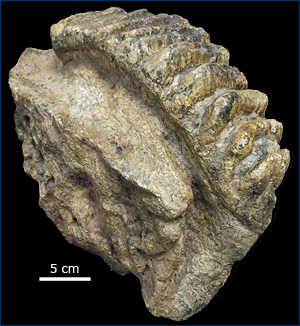
The Stegodontidae
Stegodontids
 A tooth of Stegodon from Java, Indonesia; specimen no. 33658 from the UCMP collections. |
The earliest Stegolophodon fossil is from the early to middle Miocene in Thailand. The genus spread from its southeast origins along the coastline of East Asia. It is thought that this northward movement of the genus is a result of the mid-Miocene climatic warming (Saegusa, 1996). The genus Stegodon evolved from Stegolophodon. It most likely originated during the Pliocene in South China based on the high diversity of this genus in the area, however there is a reported record of the genus from Kenya, Africa dated at 6.5 million years ago. From South China, Stegodon rapidly diversified and spread through Asia (Saegusa, 1996). They were able to swim and reached many islands in southeastern Asia (even islands that were not connected during low sea levels of glaciation periods). Stegodon diversified on the Japan islands resulting in several endemic species (Saegusa et al., 2005).
Elephants reached Asia during the Pliocene and by this time stegodontids were very diverse suggesting that elephants and stegodontids may have co-existed. The loss of stegodontids in Africa may have been the result of increasing grassland on the continent.
New content researched and written by Kaitlin Maguire, 11/2010; Stegodon tooth photo by Dave Smith, UCMP